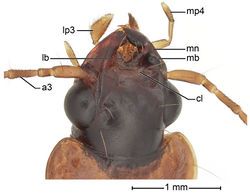Badister\according to Erwin et al 2011
| Notice: | This page is derived from the original publication listed below, whose author(s) should always be credited. Further contributors may edit and improve the content of this page and, consequently, need to be credited as well (see page history). Any assessment of factual correctness requires a careful review of the original article as well as of subsequent contributions.
If you are uncertain whether your planned contribution is correct or not, we suggest that you use the associated discussion page instead of editing the page directly. This page should be cited as follows (rationale):
Citation formats to copy and paste
BibTeX: @article{Erwin2011ZooKeys147, RIS/ Endnote: TY - JOUR Wikipedia/ Citizendium: <ref name="Erwin2011ZooKeys147">{{Citation See also the citation download page at the journal. |
Ordo: Coleoptera
Familia: Carabidae
Name
Badister Clairville, 1806 – Wikispecies link – Pensoft Profile
Diagnosis
In addition to the features presented in the generic diagnosis and description above, all of the Western Hemisphere species of the typical subgenus have the right mandible deeply notched (Fig. 2, mn), and a row of setae on each latero-ventral margin of tarsomere 5. Another useful attribute in distinguishing the subgenera is the relative length of the hind tarsi. In adults of Badister and Trimorphus, the posterior tarsi are more than 3/4 the length of the hind tibiae; in Baudia, the hind tarsi are perceptibly relatively shorter.
Geographic Distribution
(Western Hemisphere).—The known range of this subgenus includes Amazonian Perú in South America, Middle American countries of Costa Rica, Honduras, Belize and México, and the North American countries of USA and Canada.
Key to the Western Hemisphere Species of Subgenus Badister Clairville, 1806 (Modified from Ball 1959[1])
Taxon Treatment
- Erwin, T; Ball, G; 2011: Badister Clairville 1806: A new species and new continental record for the nominate subgenus in Amazonian Perú (Coleoptera, Carabidae, Licinini) ZooKeys, 147: 399-417. doi
Other References
- ↑ Ball G (1959) A taxonomic study of the North American Licinini with notes on the Old World species of the Genus Diplocheila Brullé (Coleoptera). Memoirs of the American Entomological Society, 16, iv + 1–258.
Images
|
